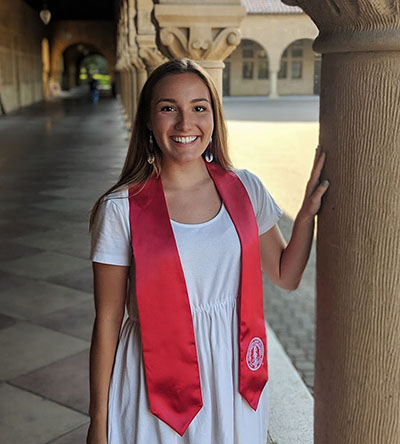Postbac Poster Day Goes Virtual
Hundreds of Young Researchers Present Their Work Online
The COVID-19 pandemic has dramatically altered the way scientists are doing their work. Nevertheless, scientific research is a highly collaborative and interactive enterprise, so it remains essential for researchers to share and discuss their ideas and discoveries.
Every spring, the NIH’s Postbac Poster Day offers recent college graduates participating in the NIH’s Postbaccalaureate IRTA program the chance to show off the fruits of their labors and talk about their projects with both their fellow postbacs and the NIH’s many seasoned scientific veterans. Due to the need to maintain social distancing, the NIH's Office of Intramural Training and Education (OITE) went through considerable effort to move this year’s Postbac Poster Day to an online forum. The OITE staff's hard work paid off handsomely, with more than 870 postbacs presenting their research via WebEx on April 28, 29, and 30. Keep reading for a few examples of the fascinating scientific questions NIH’s latest crop of postbacs has been investigating.
Amy Kwarteng: Peering Into Adolescent Brains for Signs of Parents’ Substance Use

Amy traces her passion for science to her participation in school science fairs while growing up in Chicago, particularly a middle school experiment in which she examined how certain ingredients in commercial shampoos change the tensile strength of human hair. However, after a teenage family friend’s struggle with substance use ended with a fatal overdose, her focus shifted to the study of how drugs and alcohol affect the adolescent brain.
Nowadays, under the guidance of the IRP’s Brenda Curtis, Ph.D., Amy investigates how the brain processes rewards differently in children with at least one parent who has had a substance use disorder compared to kids who have no such family history. By analyzing brain imaging data from a longitudinal NIH study of 9- and 10-year-olds, Amy discovered that young people with a family history of substance use disorders, despite never having used drugs themselves, nevertheless show greater activity in certain reward-related brain areas when anticipating a reward. Though it remains unclear whether these differences are genetic or environmental in origin, Amy’s findings pose the possibility that prevention programs could address these differences and help head off substance use disorders in adolescents whose parents have struggled with drugs or alcohol.
“My postbaccalaureate experience at the NIH has been incredibly rewarding thus far,” Amy says. “When I considered taking two gap years before medical school, I desired opportunities that would not only allow me to obtain additional clinical experience but also allow me to share my research in various facets. This postbac experience has allowed me to do exactly that, as well as to learn from and work with individuals who serve as the linchpins of drug addiction research.”
Alfredo Villalobos-Perez: Measuring a Marker of Metabolic Disease

After leaving Mexico with his family at the age of 7, Alfredo spent his childhood following the tomato and corn season from Florida to North Carolina each year with his farm worker parents. His upbringing in the migrant farming community, in which obesity and its accompanying health problems are alarmingly common, had a lasting influence on his career amibitions. He currently plans to become a cardiologist and pursue research focused on combating the American obesity epidemic.
A major step on his path towards that future is his current work in the lab of IRP Assitant Clinical Investigator Stephanie Chung, M.B.B.S., where he has been studying GlycA, a sign of bodily inflammation that can be detected in the blood using a technique called nuclear magnetic resonance (NMR) spectroscopy. GlycA had previously been found to be high in adults with insulin resistance, type 2 diabetes, and heart disease — all common health consequences of obesity — and Alfredo has discovered that GlycA is elevated in adolescents and young adults with type 2 diabetes as well. Moreover, he has discovered that higher GlycA in young people is associated with greater resistance to insulin and a higher amount of small LDL cholesterol particles in the blood, which is a risk factor for heart disease. His results suggest that GlycA could be used as a biomarker to assess metabolic and heart health in young people.
“What attracted me the most to Dr. Chung’s lab is how it connects with my experiences and the skills I want to acquire for strengthening myself as a physician-scientist,” Alfredo says. “Her focus on working to prevent childhood obesity and diabetes, especially amongst high-risk communities, is the work I see myself practicing once I enter medicine. Additionally, I am an integral team member, participating (and sometimes leading the discussion) in diabetes and obesity physiology curriculums, and contributing to patient care management by helping scribe and assist in her diabetes clinics.”
Jacob Nadel: Testing a Dietary Intervention in an Animal Model of Parkinson’s

The popular, carbohydrate-restricting ‘ketogenic’ diet forces the body to convert fat into chemicals called ketones in order to fuel our cells. While the jury is still out on the long-term health effects of that manner of eating, the existing evidence on how certain ketones affect the body has prompted immense interest in using a ketogenic diet, or ketones themselves, to treat a wide range of illnesses.
Since beginning his work last July in the lab of IRP senior investigator David Lovinger, Ph.D., Jacob has been studying how a ketone molecule called beta-hydroxybutyrate (BHB) affects the progression of symptoms in a mouse model of Parkinson’s disease, a neurological illness in which the gradual loss of certain brain cells impairs the ability to move.
"Parkinson’s disease is an incredibly prevalent disorder negatively affecting millions of people worldwide, and finding treatments has been difficult,” Jacob explains. “I was thrilled to be able to take the reins on this project because our primary goal as scientists should be improving peoples’ lives, and this project is hopefully a tangible step in that direction.”
Jacob’s experiments showed that feeding those mice a diet supplemented with BHB slowed the deterioration of their balance and coordination and also appeared to improve the functioning of the brain cells that die in Parkinson’s disease. If future studies replicate these findings and identify a biological mechanism by which ketones delay Parkinson’s symptoms, some kind of ketone chemical or dietary regimen that causes the body to produce its own ketones could one day be a therapeutic option for patients with the condition.
“Being able to be a part of this lab and spending days working alongside some of the brightest minds in neuroscience has been incredible,” Jacob says. “My experience as an NIH postbac has already made me a better scientist and critical thinker in general.”
Brooke Mounsey: Examining Exercise in Individuals Recovering from Alcohol Use Disorder

As a member of the Simpcw First Nation, a Canadian Indigenous community, working on issues that affect Indigenous groups is particularly meaningful to Brooke. Consequently, her research in the lab of IRP senior investigator Gwenyth Wallen, Ph.D., is focused on alcohol use disorder (AUD), which is a significant problem in some North American Indigenous populations.
“I’ve always been drawn to science, but I think more recently I’ve seen it as a way to conceptualize and address barriers to health,” Brooke says. “Dr. Wallen’s team has a particular focus on health behaviors and disparities among vulnerable populations, which relates to my academic and personal interests in medicine.”
Brooke has specifically been looking into how physical activity levels differ in recovering AUD patients who subsequently relapsed and resumed drinking compared to those who remained abstintent from alcohol. She has found that patients who relapsed became increasingly sedentary over time, whereas those who did not maintained fairly consistent levels of physical activity. The results suggest that monitoring patients’ physical activity could yield useful information for gauging their likelihood of relapse and possibly signal the need for additional intervention before they fall of the wagon.
“I’ve loved being at the NIH this year!” Brooke says. “I’ve felt challenged to come up with new ideas and grow professionally. I also feel incredibly lucky to have found such great mentors and to be part of a supportive team.”
Antoinette Charles: Digging Into Diversity in Mental Health Research

Some scientists recall early childhood memories of catching tadpoles or playing mad scientist with the contents of their parents’ spice cabinets, but many others had to experiment (pun intended) before they discovered a passion for investigating the natural world. Antoinette Charles falls into the latter camp, having sampled a variety of options during her first year at Georgia State University in her hometown of Atlanta.
“As a college freshman, I explored different courses like English, psychology, and biology, but I did not feel passion until I discovered neuroscience,” she explains. “It has a multidisciplinary approach to studying the nervous system that allowed me to delve into the fields of biology, chemistry, psychology, and philosophy. My course work ignited an intellectual curiosity to pursue research because of the excitement of cultivating an experiment from beginning to end, the process of persevering toward results, and my drive to make discoveries.”
Antoinette’s particular interest in mental health disparities within the African American community led her to the research group of Joyce Chung, M.D., Deputy Clinical Director for the NIH’s National Institute of Mental Health (NIMH). It is widely known that minorities and women participate in clinical research less often than other groups, and Antoinette is investigating the extent of this issue in NIMH’s own studies. Her analysis found that African Americans and Latinos are underrepresented in IRP mental health studies, leading Antoinette to suggest strategies to entice more individuals from these groups to participate, such as utilizing community listservs and partnering with faith-based organizations.
“My experience as a postbac has been a blessing,” Antoinette says. “I am grateful for the relationships that I have developed with mentors, NIH staff, and fellow postbacs. It has been an eye-opening experience to learn about the different aspects of research and medicine, and the NIH community provided a haven to help discover my identity outside of being a student.”
With the help of these young researchers and their many peers in the IRP, research at the NIH marches on despite the challenges of the COVID-19 pandemic. These aspiring scientists and clinicians are taking full advantage of the opportunity to gain important scientific skills and contribute to work that has the potential to improve many people’s lives.
Subscribe to our weekly newsletter to stay up-to-date on the latest breakthroughs in the NIH Intramural Research Program.
Related Blog Posts
This page was last updated on Monday, January 29, 2024
